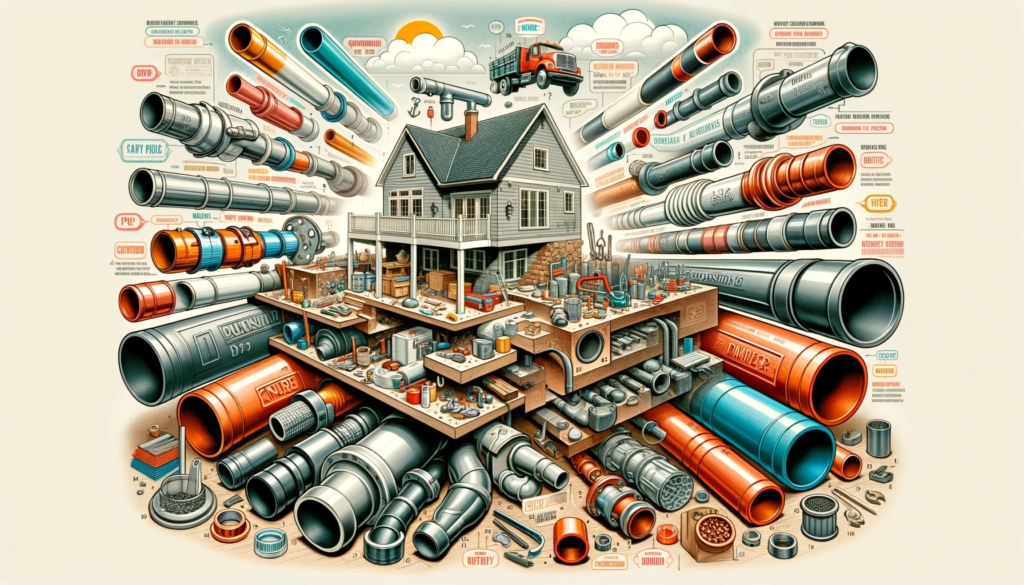Exploring Your Drain Pipe Material Options

Choosing the right drain pipe materials can mean the difference between a reliable, low-maintenance drainage system and one that is prone to leaks, blockages, and early deterioration. As a homeowner who has experienced both ends of this spectrum, I appreciate how crucial it is to understand the available materials and their implications for your home’s plumbing.
Next we’ll dive deep into two popular types of drain pipe materials: PVC and cast iron. I’ve seen firsthand how selecting the proper type can ensure durability, cost-effectiveness, and peace of mind.
For those interested in the broader basics of residential drains, you might find this article helpful: Understanding Residential Drains.
PVC Drain Pipes – Affordable and Durable
PVC, or polyvinyl chloride, has become one of the most popular choices for residential drain pipes, and for good reason. PVC pipes are recognized for their lightweight nature, resistance to corrosion, and impressive durability. Notably, these pipes won’t succumb to the degradation that can come from both the chemicals found in wastewater and the soil environments in which they are buried.
Here are some of the major benefits of opting for PVC drain pipes:
- Cost-effectiveness: PVC plumbing is generally less expensive than metal piping.
- Ease of Installation: The lightweight characteristic of PVC makes it easier to handle, cut, and fit together, reducing labor costs.
- Corrosion Resistance: PVC does not corrode, which means it can last for decades without being replaced.
- Chemical Resistance: It stands up well against household chemicals that go down the drain, ensuring its longevity.
However, there are some considerations to keep in mind:
- Temperature Sensitivity: PVC can warp when exposed to high temperatures, so it’s not suitable for hot water lines.
- UV Light Sensitivity: If installed where it can be exposed to sunlight, PVC may degrade over time.
When incorporating PVC into your home, it’s important to consult with a professional to ensure it meets local building codes and is appropriate for your particular application. Moreover, while PVC is indeed a strong material, ensuring that it is installed with correct slopes and supports will maximize its lifespan and prevent sagging or bellies in the lines which can lead to blockages.
For a deeper look into the types of systems suited for PVC and other materials, check out: Types of Home Drainage Systems.
The Sturdiness of Cast Iron Piping
Moving onto the heavier side of things, cast iron piping has been a trusted material in the plumbing industry for centuries—quite literally. This traditional material offers a sturdy and dense solution, making it ideal for main sewer lines and other areas where robustness is key.
The appeal of cast iron piping lies in its durability. These pipes can last up to 100 years, sometimes longer, under proper conditions. Cast iron is also sound-dampening, which is a desirable trait in apartment buildings or residential homes where noise reduction is important. Additionally, it’s highly resistant to abrasion and heat, which further contributes to its longevity.
Consider these points when contemplating cast iron for your drains:
- Longevity: Cast iron pipes can endure the test of time with extraordinary longevity.
- Noise Reduction: Thanks to its density, it effectively reduces the sound of flowing water.
- Heat Resistance: It’s capable of handling higher temperatures without warping or damage.
Yet, with these benefits come certain disadvantages:
- Weight: Cast iron pipes are very heavy, making them more difficult to transport and install.
- Corrosion: Over time, cast iron can corrode if not properly maintained or if exposed to certain conditions.
- Cost: It is typically more expensive than PVC both in material and installation costs due to its weight and labor-intensive handling.
It’s crucial to assess if your home needs the robustness that cast iron offers or if a more cost-effective and sustainable solution like PVC would suffice.
To understand more about seasonal care specifically for your pipes, be sure to read: Seasonal Drainage Care.
ABS Plastic Pipes – The Versatile Choice
While PVC has become widespread, ABS (acrylonitrile butadiene styrene) pipes are another plastic alternative that share some similarities yet distinct differences. The primary contrast between the two comes down to ABS’s black color and its composition, which is a bit stronger and more rigid than PVC. This can make it more resistant to physical damage during installation and use.
Here are the advantages and scenarios where ABS pipes excel:
- Cold Temperature Tolerance: ABS maintains its integrity in colder climates, where it is less likely to crack compared to PVC.
- One-Step Installation: Unlike PVC, which requires a primer before gluing, ABS pipes can be joined with a single step, using cement only.
- Impact Resistance: ABS is slightly tougher when it comes to resistance to impact, making it a good choice for underground use where it may be subject to external pressures.
There are, however, aspects to be wary of:
- Sunlight Sensitivity: Like PVC, ABS can degrade with prolonged exposure to UV light.
- Code Acceptance: Not all local plumbing codes accept ABS piping, so it’s essential to verify what is permissible in your area.
Given its robustness, I’ve found ABS to be particularly helpful in parts of a home that are more prone to drastic temperature changes or where a strong, impact-resistant material is desired. Yet again, a professional consultation is advised to determine the suitability of ABS pipes for different sections of your plumbing system.
Copper Drainage Pipes – The Premium Option
For those looking for a material that can provide a combination of durability and aesthetic appeal, copper is the material of choice. Often seen in older homes and high-end construction, copper pipes bring a traditional look that can be visually pleasing when exposed.
Here’s why you might consider copper for your drainage needs:
- Longevity: Copper pipes can last for 50 years or more.
- Biostatic Atmosphere: Copper naturally resists bacteria, making it beneficial for sanitary purposes.
- Recyclable: Copper is fully recyclable, and using recycled material doesn’t affect its quality or performance.
The drawbacks include:
- Cost: Copper is more expensive than plastic piping options.
- Installation Skill Level: It requires skilled labor to solder and install, adding to the cost.
- Corrosion: In certain water conditions, copper can corrode and release into the water, raising concerns over time.
Copper’s inherent qualities make it a viable option for certain homeowners, particularly those restoring historic buildings or aiming for a premium finish. However, it’s crucial to balance the aesthetic and functional benefits against the higher costs and ensure it aligns with your overall plumbing goals.
Selecting the right material for your home’s drainage system requires careful consideration of various factors such as climate, soil, water characteristics, and budget. Each material—be it PVC, cast iron, ABS, or copper—carries its own set of pros and cons.
Environmental Considerations and Pipe Materials
When it comes to selecting drain pipe materials, we must also reckon with the environmental impact each choice may have. Sustainable living is not just a trend; it’s become an essential part of how we think about home improvement. As homeowners, we play a significant role in this movement by choosing materials that reduce environmental harm.
Some key points to consider are:
- Recyclability: Materials like copper and to some extent, PVC and ABS, can be recycled, reducing the amount of waste that ends up in landfills.
- Production Footprint: The manufacturing processes for different materials have varying levels of energy consumption and greenhouse gas emissions.
- Service Life: Long-lasting materials mean less frequent replacement and, consequently, less material waste.
Installing Drain Pipes: Professional vs. DIY
There’s a thrill in taking on home improvement projects yourself. However, when it comes to drainage systems, it’s crucial to know your limits. I’ve experienced plenty of mishaps in my DIY endeavors, so I understand the balance between personal capability and the need for professional expertise.
Choosing whether to install your drain pipes yourself or to hire a professional involves several considerations:
- Complexity: If the job is straightforward, a DIY approach might be feasible. But complex installations often require professional skills.
- Tools: Professional plumbers have specialized tools that make the job faster and more efficient.
- Building Codes: A professional is familiar with local codes and can ensure your system is up to standard.
A few situations where DIY might make sense:
- Simple Repairs: Tightening fittings or replacing small sections of piping.
- Accessible Projects: Jobs that don’t require major alterations to the structure of your home.
For more complex scenarios, consider these factors:
- Safety: Improper installation can lead to serious issues, including water damage and mold growth.
- Warranty: Incorrect installation might void warranties on your home or the products used.
- Resale Value: A properly installed system can be a strong selling point if you ever choose to sell your home.
Whether you’re drawn to the challenge or are just trying to save some money, it’s important to weigh the risks and rewards carefully. Sometimes, paying for professional services can save you from future headaches and added expenses.
Common Issues with Drain Pipes and How to Tackle Them
Throughout my time as a homeowner, I’ve learned that some drainage trouble is inevitable. But, being in the know about common drain pipe issues can save you from stress and costly damages. Here are some issues I’ve encountered and how I’ve handled them:
- Clogs and blockages: Regularly remove hair, food scraps, and other debris before they can accumulate.
- Leaks: Inspect pipe joints and fittings for any signs of wear or damage. Simple sealing or tightening might fix minor leaks.
- Tree root intrusion: Keep an eye on the growth of nearby tree roots, which may invade and damage pipes.
If you find yourself facing these or other plumbing problems, I’ve shared my experiences and solutions in a dedicated piece:
Cost-Effective Drainage: Saving Money without Sacrificing Quality
We all love to save where we can, especially when it comes to home maintenance. Here’s how I’ve managed to ensure cost-effective drainage solutions that don’t compromise on quality:
- Choose the right materials: Opt for materials that offer the best value for your specific needs over the long term.
- Proper installation: Ensuring proper installation the first time around prevents future costly repairs.
- Preventive maintenance: Regular checks and minor fixes can prevent large-scale problems.
For further details on how to maximize your investment, take a look at my tips for affordable yet reliable drainage solutions:
We’ve now covered an array of topics from the intricacies of different materials to tackling typical problems and being economical with your choices. By considering the factors we’ve discussed, you’ll be in a better position to choose a drainage system that suits your home’s needs and your environmental values.
Final Thoughts on Selecting the Right Drain Pipe Material
In reflecting on our journey through the world of drain pipe materials, we circle back to the idea that making the right selection is more of an art than a science. It’s a balance of individual circumstances, environmental considerations, and pragmatic decision-making. Here are my parting thoughts:
Recap of Key Considerations:
- Durability: How long do you need your pipes to last without major issues?
- Cost: What does your budget allow for both the immediate and long-term?
- Functionality: What are the specific needs of your household’s drainage?
- Local Codes: Are all materials you’re considering compliant with regulations?
Final Advice:
- Stay informed—continue to learn about the materials and technologies available.
- Assess your needs thoroughly—don’t over or underestimate the requirements of your plumbing system.
- Consult professionals—glean insights from those who work with these materials every day.
It’s worth mentioning that while we’ve targeted the most common materials, there are always innovations on the horizon, like high-density polyethylene (HDPE) and trenchless technology, which are having an impact on home drainage solutions.
Now that you’re armed with this knowledge, I urge you to take the time to assess all the angles before making a decision. Exploring further, such as learning about DIY Drain Repair, can provide even more insight into handling repairs yourself.




